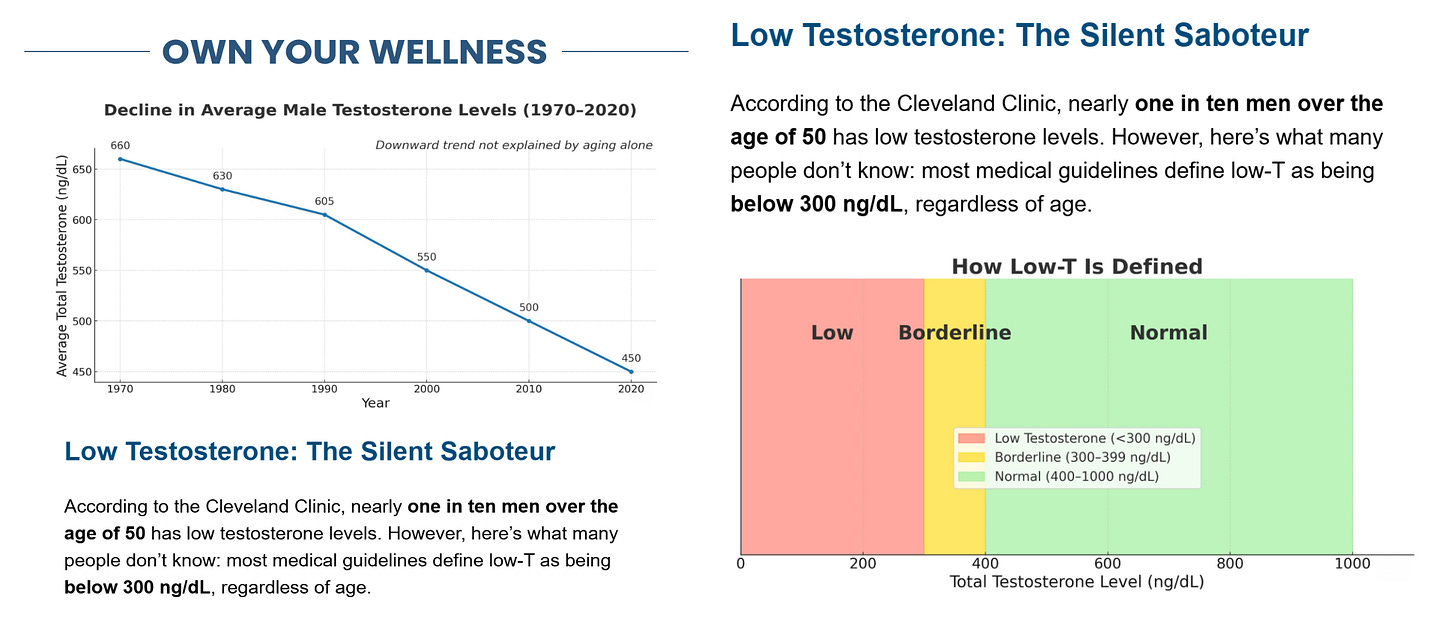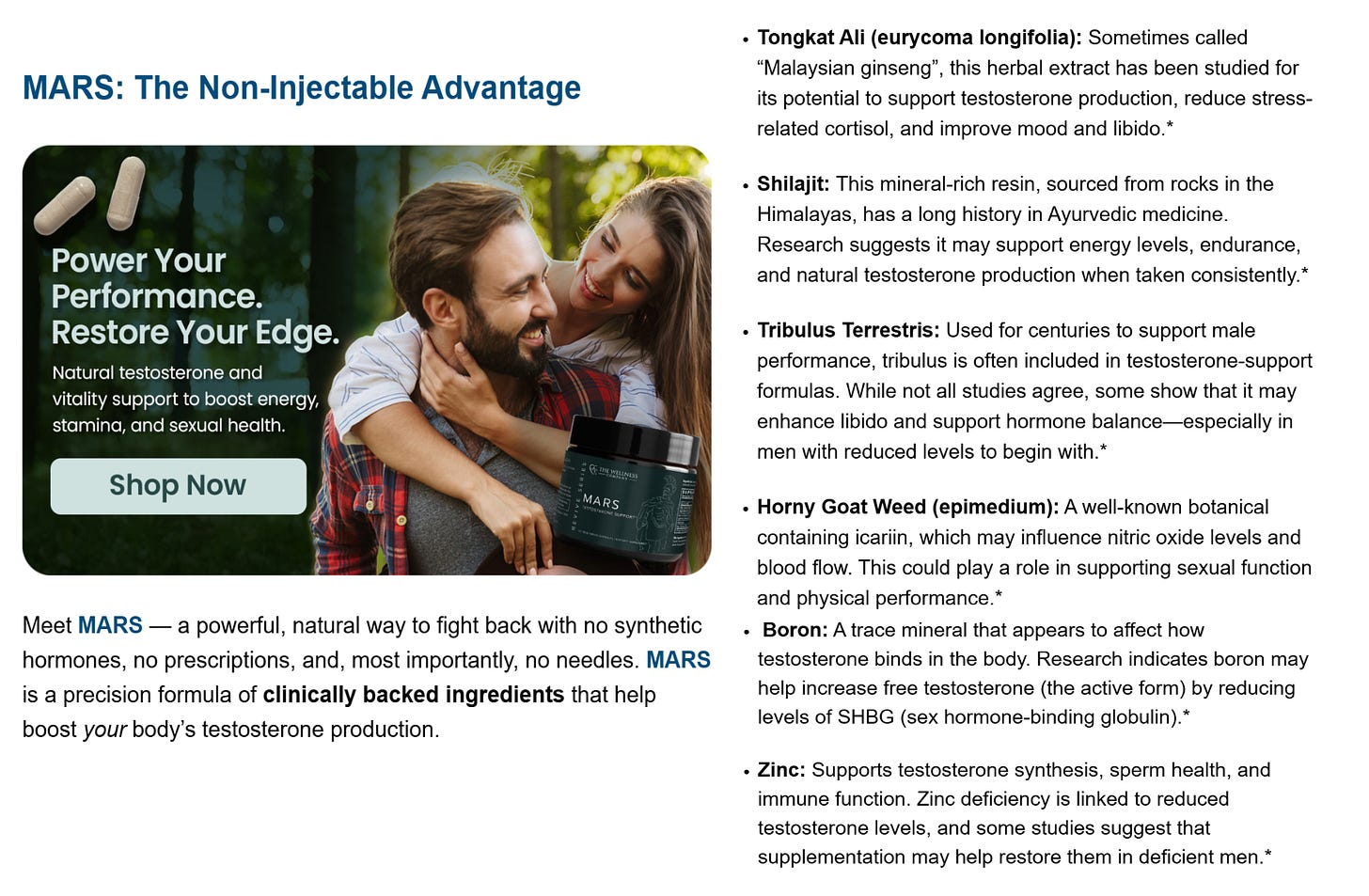Herbal Supplement Strategies for Boosting Testosterone
Many looking for natural ways instead of synthetic injections
By Peter A. McCullough, MD, MPH
The Wellness Company has put out some excellent information in its newsletter on the problem of androgen insufficiency in the series Own Your Own Wellness. Be sure you are signed up for this newsletter.
Introduction
Interest in phytotherapy for hypogonadism has risen as many men seek “natural” alternatives to pharmacologic testosterone‑replacement therapy (TRT). While exogenous testosterone can improve muscle mass and libido, it may suppress fertility, elevate hematocrit, and alter lipid and prostate profiles. Consequently, diverse herbal compounds—adaptogens, botanicals, and nutraceutical extracts—are being studied for their potential to augment the hypothalamic‑pituitary‑gonadal (HPG) axis or reduce androgen‑lowering stress signals. Evidence quality varies widely; rigorous randomized trials remain sparse.
1. Ashwagandha
Ashwagandha, a perennial shrub in the nightshade family, is among the most investigated adaptogenic herbs. Its bioactive constituents (withanolides) exhibit antioxidant, anti‑inflammatory, and cortisol‑lowering properties that may indirectly support testosterone synthesis.
- A double‑blind trial in 75 infertile men given 5 g/day of root powder for 90 days yielded a 17 % rise in testosterone and improved sperm parameters ¹.
- A 12‑week RCT in healthy adults (600 mg/day standardized extract KSM‑66) increased total T by 14.7 % and enhanced strength and cardiorespiratory fitness compared to placebo ².
Mechanistically, ashwagandha appears to enhance luteinizing‑hormone (LH) secretion stimulating Leydig cells to produce testosterone, while suppressing cortisol—a known antagonist of gonadal steroidogenesis.
Cautions remain minor: gastrointestinal discomfort and occasional somnolence; rare reports of hepatic enzyme elevation are under review ³.
2. Fenugreek
Fenugreek seed extract contains furostanolic saponins (protodioscin and diosgenin) that inhibit 5‑α‑reductase and aromatase, theoretically maintaining higher testosterone by reducing conversion to dihydrotestosterone (DHT) and estradiol.
- Wilborn et al., J Int Soc Sports Nutr 2010 (500 mg/day extract for 8 weeks) documented significant rises in free T (+46 %) and improved strength in resistance‑trained men ⁴.
- Subsequent RCTs using extracts standardized to 50 % fenuside saponins confirmed moderate increases in free T but inconsistent changes in total T ⁵.
Reported adverse events are rare, though gastrointestinal bloating and maple‑syrup–like odor (from sotolon) occur. Diabetic patients should monitor glucose, as fenugreek also enhances insulin sensitivity.
3. Jack or Malaysian Tongkat Ali
Eurycoma longifolia root, native to Southeast Asia, is rich in quassinoids (eurycomanone) that stimulate Leydig‑cell steroidogenesis and may free bound testosterone by reducing SHBG binding affinity.
- A meta‑analysis covering 16 trials (n ≈ 1,200 men) found mean increases of 100–200 ng/dL total T versus placebo ⁶.
- A three‑month hypo‑gonadal male study observed 90 % achieving normogonadal levels (>300 ng/dL) after daily 200 mg extract ⁷.
Beyond hormone metrics, trial participants report improvements in erectile function and mood, suggesting psychosomatic reinforcement. Safety data show mild insomnia or irritability in a minority; liver/kidney function largely unaffected up to 600 mg/day for 12 weeks ⁸.
4. Panax ginseng (Korean Red Ginseng)
Ginsenosides—triterpenoid saponins—enhance nitric‑oxide synthase and potentially the dopaminergic regulation of GnRH secretion.
- Jang DJ et al., Int J Impot Res 2008 reported increased LH and total T after eight weeks of 1.5 g/day red ginseng.
- Additionally, rodent models demonstrate ginsenoside‑induced up‑regulation of steroidogenic acute‑regulatory (StAR) protein ⁹.
Although effects are generally mild (<10 % rise), improved libido and mood may secondarily amplify endogenous testosterone trajectories. Contraindications include uncontrolled hypertension and concurrent anticoagulation.
5. Tribulus terrestris
Long regarded as an aphrodisiac in Ayurvedic medicine, Tribulus owes its reputation to the steroidal glycoside protodioscin. Animal experiments show significant testosterone gains, but translation to humans is limited.
- A systematic review (Pokrywka 2021) covering 11 human RCTs concluded no consistent increase in serum T; however, subjective libido improvements were frequent ¹⁰.
- Variability may reflect unstandardized extract quality and participant baseline hormone status. In eugonadal athletes, further increases are minimal.
Safety is relatively benign—occasional gastrointestinal discomfort and rare hepatotoxicity with adulterated supplements.
6. Horny goat weed (Epimedium species)
Horny goat weed contains icariin, a flavonoid that inhibits phosphodiesterase‑5 and may increase nitric‑oxide signaling. Animal experiments show dose‑dependent rises in serum testosterone via enhanced Leydig‑cell activity (Shindel AW et al., J Sex Med 2010;7:1518‑1528). However, human trials are lacking: no randomized studies demonstrate increased testosterone in men (Ottani A et al., Fitoterapia 2021;152:104915). Thus, existing evidence supports erectile‑function benefits but not clinically meaningful androgen elevation.
7. Ginger (Zingiber officinale)
Gingerol compounds exert antioxidant and anti‑inflammatory effects that protect testicular tissue and may enhance 17β‑hydroxysteroid dehydrogenase activity. In an RCT of infertile men given 3 g/day dry powder for three months, sperm count, motility, and serum T rose 17 % ¹¹. These findings underscore ginger’s metabolic synergy—improved insulin sensitivity and decreased lipid peroxidation also contribute to androgen preservation.
8. Puncture vine and Shilajit (Formed herbo‑mineral mixture)
Purified Shilajit (asphaltum) containing fulvic acids was studied in 75 men aged 45–55: 500 mg/day for 90 days increased total T by ~20 % and DHEA by 30 % versus baseline ¹². Mechanisms include mitochondrial activation and antioxidant modulation rather than direct gonadotropin stimulation.
9. Boron
Boron appears to influence steroidogenesis and sex hormone–binding globulin (SHBG). A week of 10 mg/day raised free testosterone (~28 %) and decreased SHBG and estradiol in eight healthy men (Naghii MR et al., J Trace Elem Med Biol 2011;25:54‑58). Another trial found 6 mg/day for 60 days increased total T and free T while lowering inflammatory cytokines (Naghii MR et al., J Diet Suppl 2011;8:228‑239). Overall, small human studies suggest mild testosterone elevation from boron, but larger controlled trials are still lacking.
10. Zinc
Zinc is essential for Leydig‑cell function and acts as a cofactor for 17β‑hydroxysteroid dehydrogenase. Marginal deficiency reduces testosterone, while supplementation restores levels. In restricted men, 6 months of 30 mg/day zinc nearly doubled serum T (Prasad AS et al., Nutrition 1996;12:344‑348). Older adults receiving 30 mg/day × 3 months showed similar gains (Hunt CD et al., Biol Trace Elem Res 1992;32:119‑126). Conversely, excess zinc (>100 mg/day) impairs copper metabolism. Evidence supports zinc repletion—not pharmacologic megadosing—as beneficial for maintaining normal testosterone. Zinc is critical for testicular steroidogenesis and Leydig‑cell activity. Deficiency causes hypogonadism, while repletion normalizes testosterone. In controlled studies, six months of 30 mg/day zinc supplementation nearly doubled serum T in previously zinc‑restricted men (Prasad AS et al., Nutrition 1996;12:344‑348) and elevated levels in elderly men (Hunt CD et al., Biol Trace Elem Res 1992;32:119‑126). Mechanistically, zinc supports luteinizing‑hormone synthesis, inhibits aromatase, and lowers oxidative stress. Evidence indicates restoring adequate zinc improves testosterone, though megadosing offers no additional benefit.
Composite Clinical Evidence and Limitations
Across >50 human intervention studies, ashwagandha, fenugreek, and Eurycoma longifolia show the most reproducible serum‑testosterone elevations (10–25 %). Others—Panax, Tribulus, ginger, or shilajit—exert more modest or inconsistent effects. Heterogeneity stems from small sample sizes, brief durations (<12 weeks), varying extraction methods, and lack of blinding. The Wellness Company MARS product incorporates six of the ingredients in this review as an evidence-based and reasonable approach for low testosterone avoiding many of the pitfalls with other sex-boosting supplements ¹³.
Long‑term cardiovascular and prostate safety data remain sparse. Interactions with anti‑diabetic, anti‑hypertensive, or anticoagulant drugs require caution. The evidence base therefore supports these products as adjuncts for better sexual health before consideration of testosterone injections.
Conclusion
Nonhormonal, plant‑derived therapies offer appealing avenues for men seeking to improve vitality and modestly raise testosterone without exogenous hormones. Among current candidates, ashwagandha, fenugreek, Eurycoma longifolia, and low-dose zinc display the strongest clinical signal for increasing total or free testosterone while enhancing muscle strength, sexual health, and mood. Yet, the magnitudes of change are moderate, study designs limited, and product quality variable. Future long-term placebo‑controlled using standardized extracts, transparent formulation, and serial measurements of T, free T, LH, FSH, and hemoglobin will be important.
Please subscribe to FOCAL POINTS as a paying ($5 monthly) or founder member so we can continue to bring you the truth.
Peter A. McCullough, MD, MPH
Chief Scientific Officer, The Wellness Company
References
1. Mahdi AA et al. Fertil Steril. 2011;95:994‑1001.
2. Lopresti AL et al. Am J Men’s Health. 2019;13:1557988319835985.
3. Upadhyay N et al. J Ethnopharmacol. 2021;265:113329.
4. Wilborn CD et al. J Int Soc Sports Nutr. 2010;7:34.
5. Steels E et al. Phytother Res. 2020;34:1330‑1338.
6. Ismail SB et al. Biomed Res Int. 2012;2012:429268.
7. Chan KL et al. Andrologia. 2021;53:e13908.
8. Talbott SM et al. J Diet Suppl. 2021;18:316‑331.
9. Jang DJ et al. Int J Impot Res. 2008;20:241‑245.
10. Pokrywka A et al. Nutrients. 2021;13:547.
11. Khaki A et al. Int J Reprod Biomed. 2015;13:271‑276.
12. Pandit S et al. Andrologia. 2016;48:963‑972.
13. Pawar RS et al. Drug Test Anal. 2022;14:1236‑1245.





And have the researchers included females in their investigations? After all, females also have testosterone which depletes during menopause. Be interesting if these herbal supplements work for women too.
Nicholas or Dr McCullough, could one of you please do a write up on whether or not one or more or all of the current flu shots are mRNA shots? People need to know.